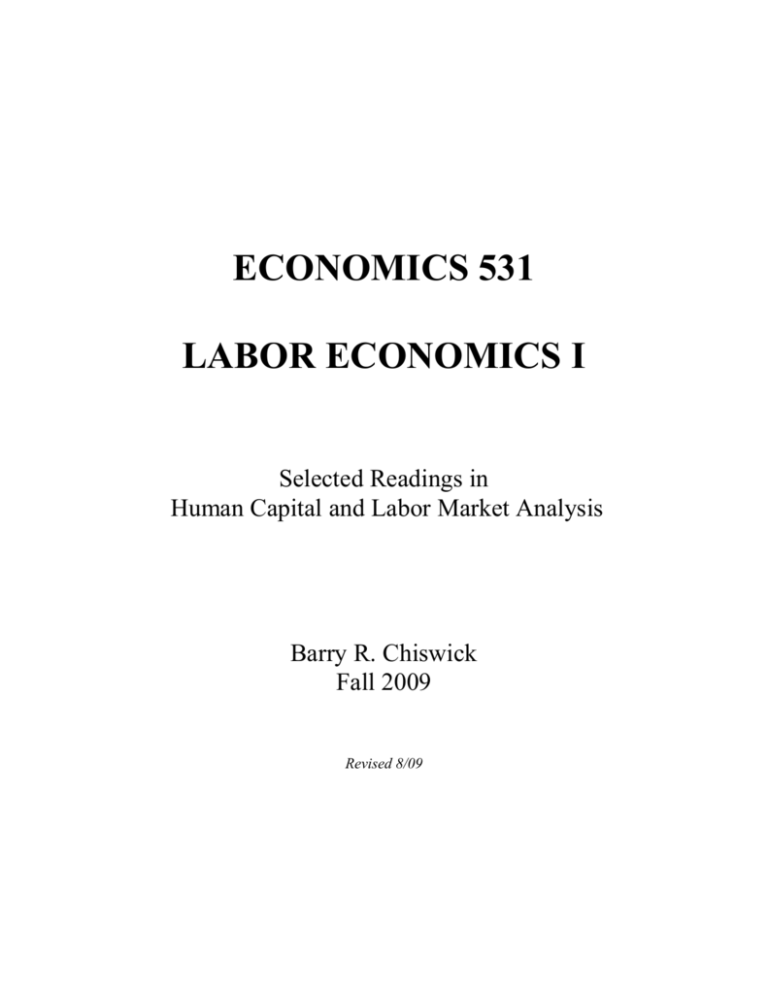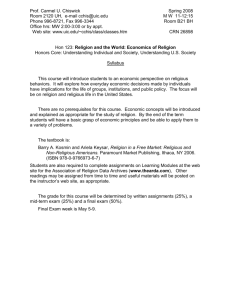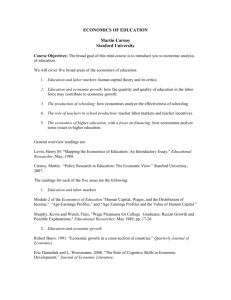ECON531 - Barry R. Chiswick
advertisement

ECONOMICS 531 LABOR ECONOMICS I Selected Readings in Human Capital and Labor Market Analysis Barry R. Chiswick Fall 2009 Revised 8/09 1 Economics 531 Labor Economics I Monday, 6-8:30 PM Barry R. Chiswick Fall 2009 Office Hours: Monday, 3:30-5:00 & by appointment Email: brchis@uic.edu Office: 724 UH Phone: 996-6240 This course will focus on the application of the principles of human capital theory to labor markets, and in particular on the determination of skills and the effects of skill on labor market outcomes. Its prerequisite is satisfactory completion of Economics 501 or Economics 520, or an equivalent course. There is no graduate level labor economics textbook. Therefore, you will have the opportunity to read the original research papers. Students without prior experience in an undergraduate course in Labor Economics are advised to do additional background reading in an advanced undergraduate textbook. An excellent undergraduate textbook that provides a foundation for the more advanced readings is: Ronald G. Ehrenberg and Robert S. Smith, Modern Labor Economics: Theory and Public Policy, Glenview, IL: Scott, Foresman and Co. (Any edition is ok.) Read chapters 1 and 2 as an introduction to Labor Economics and other chapters to get a broader perspective on the field. The schedule and selected bibliography are subject to revision as the course progresses. Core readings are designated by *. Many of the articles on the reading list, especially those that are at least five years old, can be accessed using JSTOR which is available via the UIC Library homepage. Other papers are available on the IZA webpage. Go to www.iza.org, click on publications, then on Discussion papers. The course will include a two hour final exam. In addition, each student is to write a 1,500 word review of an article of their choice, subject to approval by the instructor. Some students will be given the opportunity to give an oral presentation of their review. Since the Illinois Economics Association Annual Meeting will be held on the UIC campus during the semester (October 16-17), each student will write an assessment (of about 1,000 words) of one session held at this meeting. The class will not meet on Labor Day, September 7, or September 28. If time permits there will be a review session in the last class meeting. 2 Schedule and Selected Biography I. Introduction (1/2 Week) *Ehrenberg and Smith, Chapters 1-2 II. Human Capital Theory (3-1/2 Weeks) 1. The Theory *Ehrenberg and Smith, Chapters 9 and 5. *Gary S. Becker, Human Capital, Part 1, NBER, 3rd Edition. (Note: This book was cited in the award of Becker’s 1992 Nobel Prize in Economics). *Theodore W. Schultz, “The Value of the Ability to Deal with Disequilibria,” Journal of Economic Literature, September 1975, pp. 827-846. *Cotton Mather Lindsay, “Measuring Human Capital Returns,” Journal of Political Economy, November 1971, 1, 195-1, 215. *Theodore W. Schultz, ed. Investment in Human Beings, Supplement, Journal of Political Economy, October, 1962. (esp. articles by Becker and Mincer) Jack Hirshleifer, “On the Theory of Optimal Investment Decision,” Journal of Political Economy, August 1958, pp. 329-352. (Only first part of this article is pertinent.). Yoram Ben-Porath, “The Production of Human Capital and the Life Cycle of Earnings,” Journal of Political Economy, August 1967, pp. 352-365. Alan Blinder and Yoram Weiss, “Human Capital and Labor Supply: A Synthesis,” Journal of Political Economy, June 1976, pp. 449-472. Sherwin Rosen, “Human Capital,” The New Palgrave: A Dictionary of Economics, Macmillan Press, 1987, pp. 681-690. 2. Applications *Barry R. Chiswick, “Differences in Education and Earnings Across Racial and Ethnic Groups,” Quarterly Journal of Economics, August 1988, pp. 571-597. *W. Steven Barnett, “Benefits of Compensatory Preschool Education,” Journal of Human Resources, Vol. 27, No. 2, Spring 1992, pp. 279-312. 3 *Michael P. Shields (2008) “Why Should State Government Invest in College Education? An Equilibrium Approach for the US in 2000” IZA Discussion Paper, No 3569. Barry R. Chiswick and Paul W. Miller “Why is the Payoff to Schooling Smaller for Immigrants?” Labour Economics, 2008, 15(6) pp 1317-1340 *Ann P. Bartel and Frank R. Lichtenberg, “The Comparative Advantage of Educated Workers in Implementing New Technology,” Review of Economics and Statistics, Vol. 69, No. 1, February 1987, pp. 1-11. *Jacob Mincer “Technology and the Labor Market.” Review of the Economics of the Household 2003, 1(4). Herbert J. Walberg, “Improving the Productivity of America’s Schools,” and Ralph W. Tylor , “A Guide to Educational Trouble Shooting,” Educational Leadership, May 1984, pp. 19-30. Carmel U. Chiswick, “The Growth of Professional Occupations in U.S. Manufacturing, 19001973,” in I. Sirageldin, Research in Human Resources and Development, JAI Press, 1979, pp. 191-217. Stanley A. Horowitz and Allan Sherman, “A Direct Measure of the Relationship Between Human Capital and Productivity,” Journal of Human Resources, Winter 1980, pp. 67-77. Barry R. Chiswick and Stella Koutromanes, “An Econometric Analysis of the Demand for Private Schooling,” Research in Labor Economics, Vol. 15, 1996, pp. 5-41. 3. Human Capital vs. Screening Barry R. Chiswick, “Schooling, Screening and Income” in L. Solmon and P. Taubman (Eds.) Does College Matter? Some Evidence on the Impacts of Higher Education, Academic Press 1973, pp. 151-158. Elchanan Cohn, et al., “Further Evidence on the Screening Hypothesis” Economic Letters, Vol. 25, 1987, pp. 289-294. Kevin Lang and David Kropp, “Human Capital Versus Sorting: The Effects of Compulsory Attendance Laws,” Quarterly Journal of Economics, August 1986, pp. 609-24. M. Boisiere, J. Knight and R. Sobot “Earnings, Schooling, Ability and Cognitive Skills,” American Economic Review, December 1985, pp. 1,016-31. III. Language as Human Capital (1 Week) *Barry R. Chiswick and Paul W. Miller (2007) The Economics of Language: International Analyses (Routledge) 4 *Barry R. Chiswick and Paul W. Miller, “Modeling Immigrant’s Language Skills,” Research in Labor Economics, 2008, 27 pp 75-128 *Barry R. Chiswick and Paul W. Miller “The Endogeneity Between Language and Earnings: International Analyses,” Journal of Labor Economics, April 1995. *Barry R. Chiswick, Yew Liang Lee, and Paul W. Miller (2005) Review of Economics of the Household, 3 pp 243-268 Francisco L. Rivera – Batiz, “Quantitative Literacy and the Likelihood of Employment Among Young Adults in the United States,” Journal of Human Resources, Spring 1992, pp. 313-329. Barry R. Chiswick and Paul W. Miller, “English Language Fluency Among Immigrants in the United States,” Research in Labor Economics, Vol. 17, 1998, pp. 151-200. Teresa Casey and Christian Dustman, “Intergenerational Transmission of Language Capital and Economic Outcomes” Journal of Human Resources, 43(3), pp 660-687. IV. The Determinants of Earnings (3 Weeks) *Gary S. Becker and Barry R. Chiswick, “Education and the Distribution of Earnings,” American Economic Review, May 1966, pp. 358-69. *Barry R. Chiswick, “Interpreting the Coefficient of Schooling in the Human Capital Earnings Function,” Journal of Educational Planning and Administration, 12(2) April 1998, pp. 123-130. *Barry R. Chiswick, “Jacob Mincer, The Distribution of Earnings and the Human Capital Earnings Function.” In Shoshana Grossbard, ed., Jacob Mincer: A Pioneer of Modern Labor Economics (2005) or Review of Economics of the Household, 2003, 1(4) pp 343-361. *Soloman Polochek (2005), “Jacob Mincer and Human Capital.” In Shoshana Grossbard, ed., Jacob Mincer: A Pioneer of Modern Labor Economics (2005). *David Card and Alan B. Krueger, “Does School Quality Matter? Returns to Education and the Characteristics of Public Schools in the United States,” Journal of Political Economy, Vol. 100, No 1, February 1992, pp. 1-40. *Barry R. Chiswick, “The Effect of Americanization on the Earnings of Foreign-Born Men,” Journal of Political Economy, October 1978, pp. 897-921. *Daniel P. Kinney and Sharon P. Smith, “Age and Teaching Performance,” Journal of Higher Education, May/June 1992, pp. 282-301. *Jacob Mincer and Haim Ofek, “Interrupted Work Careers: Depreciation and Restoration of Human Capital,” Journal of Human Resources, Winter 1982, pp. 3-24. 5 Christian Belzil and Marco Leonardi “Can Risk Aversion Explain School Attainment? Evidence from Italy” Labour Economics, 2007, 14(6) pp657-670. Jorn-Steffen Pischke, “The Impact of Length of the School Year on Student Performance and Earnings: Evidence from the German Short School Years” Economic Journal, 117(523) pp 12161242. Erik Plug and WimVijverberg “Schooling, Family Background, and Adoption: Is it Nature or is it Nurture” Journal of Political Economy, June 2003, 111(3) pp 611-641. Jacob Mincer and Solomon Polachek, “Family Investments in Human Capital: Earnings of Women,” Journal of Political Economy, Supplement, March 1974, s. 76-s. 108 and “Exchange” Comment by Sandell and Shapiro and Reply by Mincer and Polachek, Journal of Human Resources, Winter 1978, pp. 103-134. Solomon Polachek, “Differences in Expected Post-School Investment as a Determinant of Market Wage Differentials,” International Economic Review, June 1975, pp. 451-470. Solomon Polachek, “Occupational Self-Selection: A Human Capital Approach to Sex Differences in Occupational Structure,” Review of Economics and Statistics, February 1981, pp. 60-69. Ronald Rizzuto and Paul Wachtel, “Further Evidence on the Returns to School Quality,” Journal of Human Resources, Spring 1980, pp. 240-254. Barry R. Chiswick, “The Earnings and Human Capital of American Jews,” Journal of Human Resources. Summer 1983, pp. 313-36. Carmel U. Chiswick, “Analysis of Earnings from Household Enterprises: Methodology and Application to Thailand,” Review of Economics and Statistics, November 1983. Ethel Jones and John Jackson, “College Grades and Labor Market Rewards,” Journal of Human Resources, Vol. 25, No. 2, Spring 1990, pp. 252-266. Joshua Angrist and Alan Krueger, “Why do World War II Veterans Earn More than Non-veterans,” Journal of Labor Economics, Vol. 12, No. 1, January 1994, pp. 74-97. Robert L. Phillips, Paul J. Andrisani, Thomas N. Daymont and Curtis L. Gilroy, “The Economic Returns to Military Service: Race-Ethnic Differences,” Social Science Quarterly, Vol. 73, No. 2, June 1992, pp. 340-359. Majorie Baldwin and William G. Johnson, “Labor Market Discrimination Against Men with Disabilities,” Journal of Human Resources, Vol. 29, No. 1, Winter 1994, pp. 1-19. John Fredland and Roger Little, “Long-Term Returns to Vocational Training: Evidence from 6 Military Sources,” Journal of Human Resources, Winter 1980, pp. 49-66. V. Compensating Wage Differentials (3 Weeks) (Ehrenberg and Smith, Chapter 3. This is a good basic discussion of the demand for labor). *Ehrenberg and Smith, Chapters 8 and 11. *Adam Smith, Wealth of Nations, Book 1, Chapters 1-3 and 10. *Albert Rees, “Compensating Wage Differentials” in A. Skinner and T. Wilson, Essays on Adam Smith. Oxford 1975, pp. 336-349. *R. E. B. Lucas, “Hedonic Wage Equations and Psychic Wages in the Return to Schooling,” American Economic Review, September 1977, pp. 549-558. *Joni Hersch and W. Kip Viscusi, “Cigarette Smoking, Seatbelt Use, and Differences in Wage-Risk Tradeoffs,” Journal of Human Resources, Vol. 25, No. 2, Spring 1990, pp. 202-228. *Reuben Gronau (2005), “Jacob Mincer and Labor Supply: Before and After.” In Shoshana Grossbard, “Jacob Mincer: A Pioneer of Modern Labor Economics (Forthcoming). Greg Duncan, “Earnings Functions and Nonpecuniary Benefits,” Journal of Human Resources, Fall 1976, pp. 462-483. Richard Thaler and Sherwin Rosen, “The Value of Saving a Life: Evidence from the Labor Market” in N.E. Terleckyj, ed., Household Production and Consumption, NBER, 1975, pp. 265-302. Barry R. Chiswick, “The Effects of Unemployment Compensation on a Seasonal Industry: Agriculture,” Journal of Political Economy, June 1976, pp. 591-602. Barry R. Chiswick, “Racial Discrimination in the Labor Market: A Test of Alternative Hypotheses,” Journal of Political Economy. November 1973, pp. 1,330-1,352. Stephen A. Woodbury and Robert G. Spiegelman, “Bonuses to Workers and Employers to Reduce Unemployment: Randomized Trials in Illinois,” American Economic Review, September 1987. John M. Abowd and Orley Ashenfelter, “Anticipated Unemployment, Temporary Layoffs, and Compensating Wage Differentials” in Sherwin Rosen, Studies in Labor Markets, NBER, 1981. VI. Job Mobility and Geographic Mobility (2 Weeks) *Ehrenberg and Smith, Chapter 10. 7 *Barry R. Chiswick, “Are Immigrants Favorably Self-Selected?” American Economic Review, May 1999, pp. 181-185. *Jacob Mincer, “Family Migration Decisions,” Journal of Political Economy, October 1978, pp. 749774. *Donald Parsons, “Specific Human Capital: An Application to Quit Rates and Lay-off Rates,” Journal of Political Economy. November 1972, pp. 1,120-43. *Aba Schwartz, “Migration, Age and Education,” Journal of Political Economy, August 1976, pp. 701-719. Ann Bartel and George Borjas, “Middle Age Job Mobility: Its Determinants and Consequences” in Seymour L. Wolfbein, ed., Men in Pre-Retirement Years, Temple University 1977. VII. Other Nonpecuniary Effects of Human Capital (1 session) *Ehrenberg and Smith, Chapter 7. *Gary S. Becker, “A Theory of the Allocation of Time,” Economic Journal, September 1965, pp. 493-517. *Duncan Thomas, John Strauss and Maria-Helena Henriques, “How Does Mother's Education Affect Child Height,” Journal of Human Resources. Spring 1991, pp. 183-211. *Michael Grossman (2003), “Household Production and Health,” Review of Economics of the Household, 1(4) pp 331-342. *Arleen Leibowitz, “In-Home Training and the Production of Children’s Human Capital,” Review of Economics of the Household, 1(4) pp 305-317. Robert T. Michael, “Measuring Nonmonetary Benefits of Education: A Survey,” Water W. McMahon and Terry G. Geske, eds., Financing Education: Overcoming Inefficiency and Inequity. 1982, pp. 119-149. *James P. Smith, “Healthy Bodies and Thick Wallets: The Dual Relation Between Health and Economic Status” Journal of Economic Perspectives, 13(2), Spring 1999, pp. 145-166. Philip Farrell and Victor R. Fuchs, “Schooling and Health: The Cigarette Connection,” Journal of Health Economics, December 1982, pp. 217-230. Donald S. Kenkel, “Health Behavior, Health Knowledge and Schooling,” Journal of Political Economy, Vol. 99, No.2, 1991, pp. 287-305. Gary S. Becker, A Treatise on the Family, Harvard, 1982.









